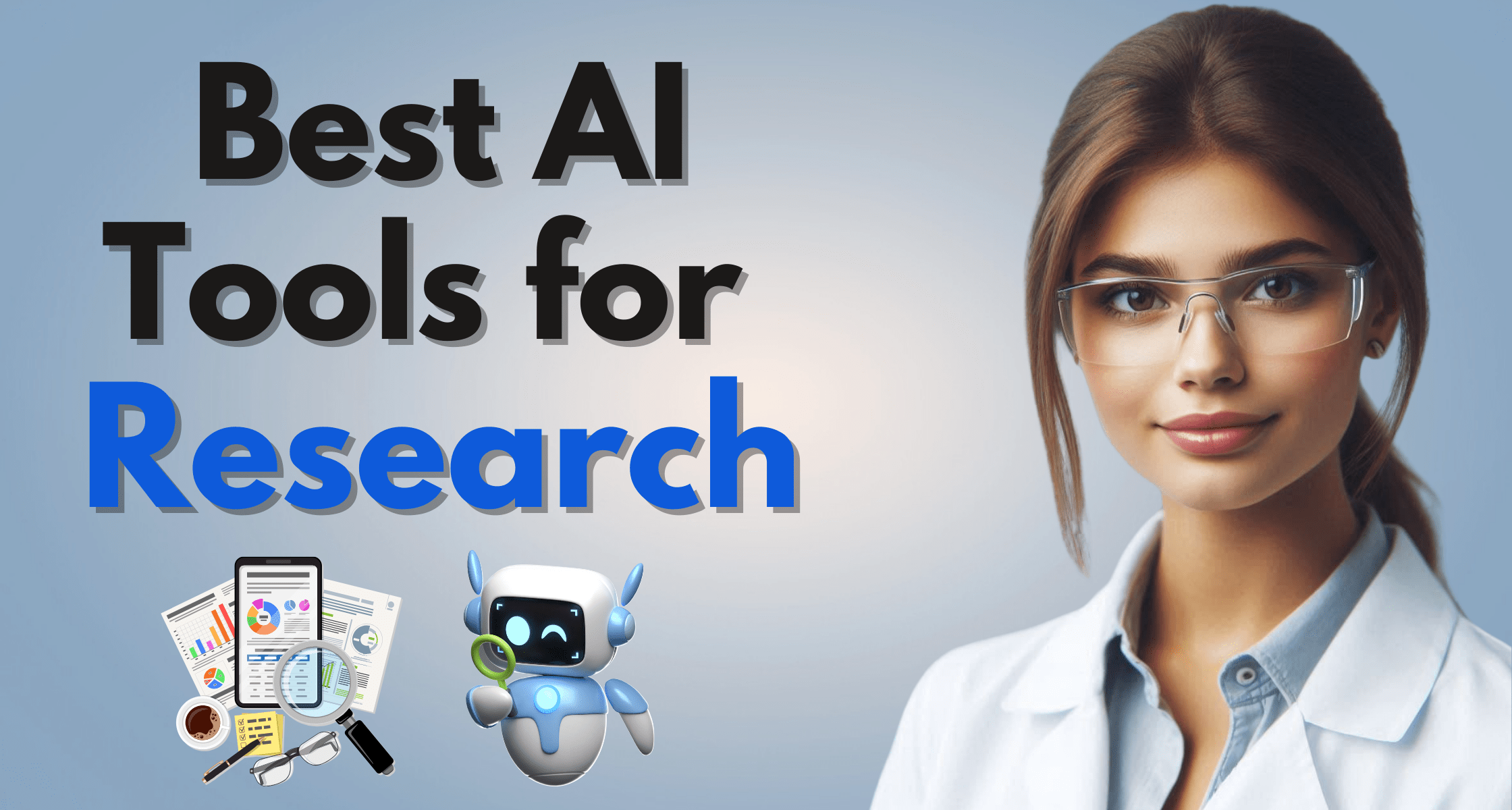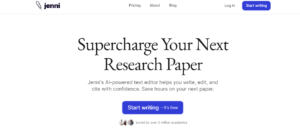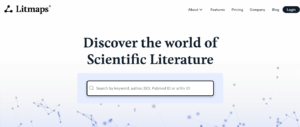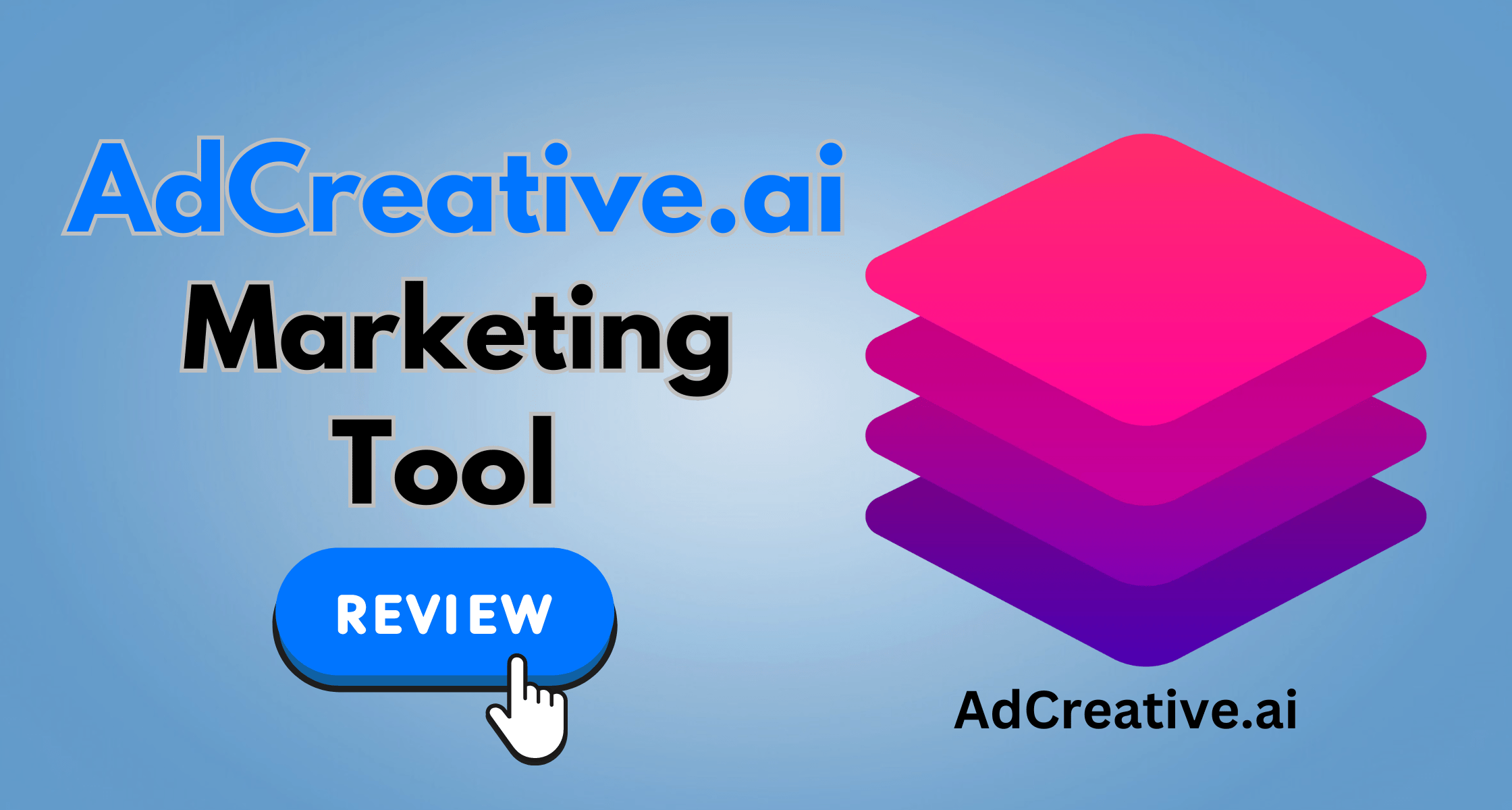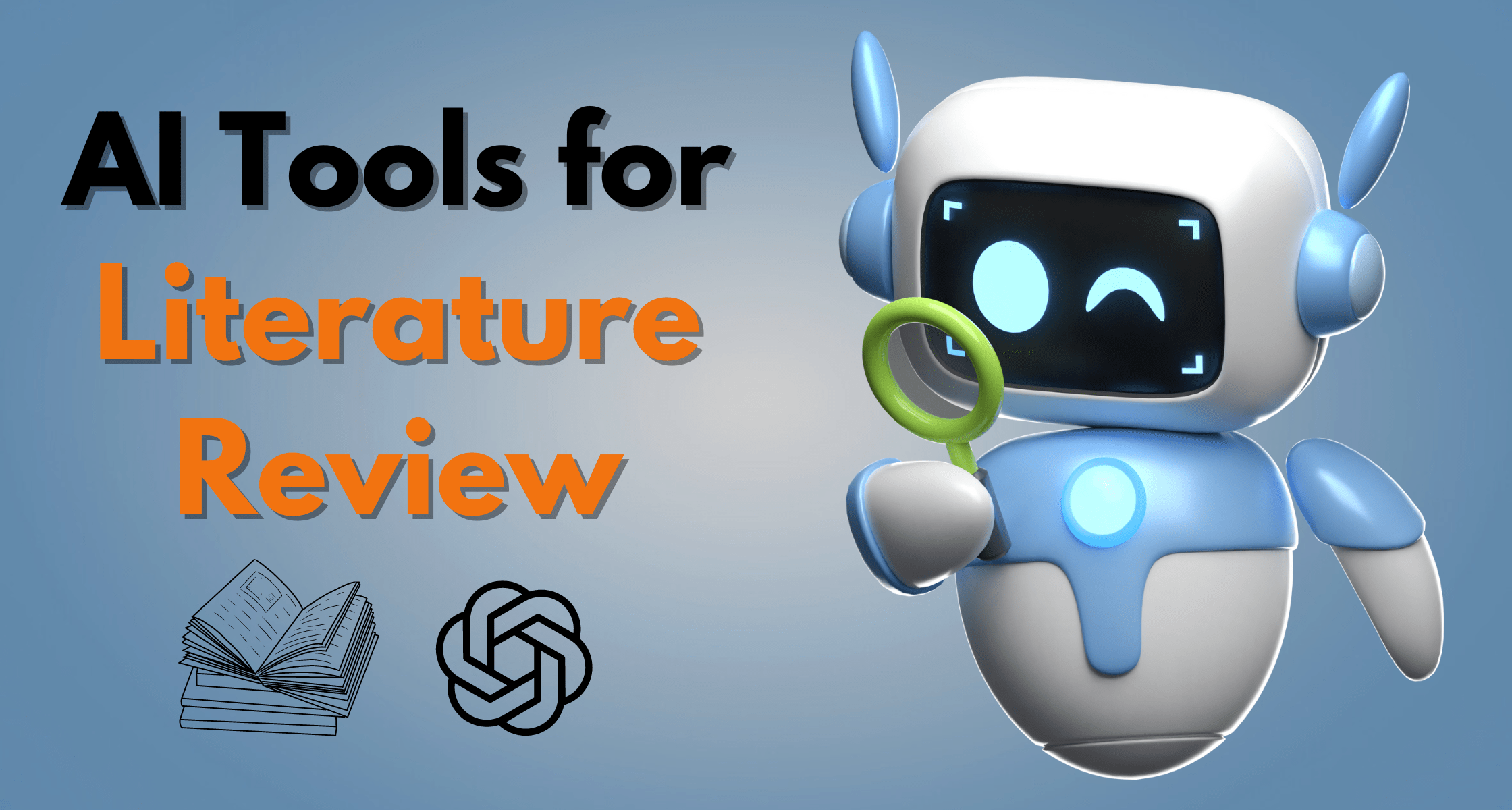Have you ever wondered how groundbreaking research is conducted at lightning speed? The secret lies in the best AI tools for research! These cutting-edge tools are transforming the research landscape, enabling discoveries that were once deemed impossible.
Artificial Intelligence is no longer just a buzzword; it’s a powerhouse driving innovation across all fields of research. From healthcare to environmental studies, AI tools are enhancing accuracy, speeding up data analysis, and unveiling insights that human researchers alone could not achieve. Imagine conducting months of research in mere days—this is the new reality with AI.
Key Benefits of AI in Research:
- Efficiency: AI automates tedious tasks, allowing researchers to focus on critical analysis and innovation.
- Accuracy: AI minimizes human error, ensuring precise and reliable results.
- Data Handling: AI tools can process vast amounts of data quickly, identifying patterns and trends that might be overlooked by human researchers.
So, why should you read this article? If you’re looking to supercharge your research capabilities, you’re in the right place. This comprehensive guide will introduce you to the best AI tools for research, reveal hidden features, and share real-life case studies. By the end, you’ll know exactly how to choose the best AI tools for research that suit your specific needs.
What You’ll Learn:
- Top AI Tools for Research: Discover the most powerful and user-friendly AI tools available today.
- Hidden Features: Uncover advanced functionalities that can give you an edge.
- Choosing the Best AI Tools for Research: Get expert tips on selecting the right tools based on your requirements.
Ready to dive into the world of AI-enhanced research? Let’s start by exploring the evolution of AI in research and how it has reached its current state of sophistication. From there, we’ll delve into the criteria for evaluating AI tools and introduce you to the top AI tools for research that you need to know about.
We’ve seen the best AI tools for headshots, students, marketing, sales, and Job-seekers in recent articles. Let’s take a look at some of the best AI research tools available today in this article.
What Is An AI Tool for Research?
Large language models (LLM) and machine learning are the foundations of AI research tools, which assist researchers in citation analysis, information gathering, literature reviews, and other tasks. They let you explore articles to find crucial information for your research because they are trained on vast volumes of data. Some of these programs can even propose grammatical changes, rewrite sections of a manuscript, and condense longer articles for ease of reading.
Evolution of AI Tools in Research

Artificial Intelligence has undergone a remarkable journey from its conceptual beginnings to its current integration into various research fields. Understanding this evolution provides valuable insights into the transformative impact AI has had on the research landscape.
History of AI in Research
Overview of AI’s Journey
- 1950s: The Birth of AI – AI emerged as a field of study, with pioneers like Alan Turing laying the groundwork for computational intelligence.
- 1960s-1970s: Early Developments – Researchers explored symbolic reasoning and problem-solving techniques, leading to the development of expert systems.
- 1980s: Rise of Machine Learning – The introduction of machine learning algorithms revolutionized AI research, enabling computers to learn from data and improve performance over time.
- 1990s: AI Assists Research – AI technologies began assisting researchers in data analysis, pattern recognition, and optimization tasks, enhancing efficiency and productivity.
- 2000s: Big Data and AI – The proliferation of big data and advancements in computing power fueled the development of more sophisticated AI models capable of handling vast amounts of data.
- 2010s: Mainstream Adoption – AI tools became increasingly accessible and user-friendly, leading to their widespread adoption across diverse research domains.
Current Trends in AI Research
Embracing Advanced Technologies:
- Automated Data Analysis: AI-powered tools streamline data processing and analysis, enabling researchers to extract insights from complex datasets with greater speed and accuracy.
- Natural Language Processing (NLP): NLP algorithms facilitate the extraction of meaningful information from unstructured text data, revolutionizing tasks such as literature reviews and information retrieval.
- Deep Learning: Deep learning techniques, inspired by the structure and function of the human brain, have propelled advancements in image recognition, speech synthesis, and predictive modeling.
- Collaborative AI: Platforms that promote collaboration among researchers by facilitating data sharing, project management, and knowledge dissemination in real-time.
Accessibility and Democratization:
- Open-Source Initiatives: The emergence of open-source AI frameworks and libraries, such as TensorFlow and PyTorch, has democratized AI research, allowing researchers worldwide to leverage state-of-the-art tools and algorithms.
- Cloud Computing: Cloud-based AI services offered by major tech companies enable researchers to access scalable computing resources and AI capabilities without significant upfront investments in hardware or infrastructure.
Future Predictions for AI in Research
Anticipated Advancements:
- AI-Driven Discovery: AI algorithms will play an increasingly integral role in hypothesis generation, experimental design, and knowledge discovery, accelerating the pace of scientific breakthroughs.
- Interdisciplinary Collaboration: AI will facilitate interdisciplinary collaboration by bridging gaps between disparate research fields, fostering innovation and cross-pollination of ideas.
- Ethical Considerations: As AI becomes more pervasive in research, ethical considerations surrounding data privacy, bias mitigation, and responsible AI development will become paramount.
- Human-AI Interaction: The development of AI systems that augment human intelligence and facilitate seamless collaboration between humans and machines will redefine the research process.
With a comprehensive understanding of the evolutionary trajectory and current trends in AI research, we are well-positioned to explore the criteria for evaluating AI research tools effectively. In the following section, we will delve into the essential factors to consider when selecting the best AI tools for research, ensuring that they align with your specific research objectives and requirements.
💡 Related guide: Top 10 Best AI Tools for Job Seekers Revealed!
Criteria for Evaluating AI Research Tools

When it comes to selecting the best AI tools for research, it’s essential to consider various factors to ensure they meet your specific needs and requirements.
Ease of Use
Importance of User-Friendly Interfaces:
- Intuitive Design: AI tools should have user-friendly interfaces that make navigation and operation effortless for researchers of all skill levels.
- Streamlined Workflow: Tools with intuitive workflows and minimal learning curves enable researchers to focus on their work rather than grappling with complex interfaces.
- Customization Options: Look for tools that offer customization options, allowing researchers to tailor the user experience to their preferences and workflow.
Accuracy and Reliability
Why Precision is Critical in Research Tools:
- Data Accuracy: AI tools must deliver accurate results to ensure the reliability of research findings and conclusions.
- Validation and Verification: Assess the tool’s validation process and ensure that it adheres to rigorous standards to minimize errors and biases.
- Consistency and Reproducibility: Reliable AI tools should produce consistent results across multiple iterations and be reproducible by other researchers.
Integration Capabilities
Compatibility with Other Research Tools and Software:
- Seamless Integration: AI tools should seamlessly integrate with existing research tools and software ecosystems to facilitate data exchange and collaboration.
- Interoperability Standards: Look for tools that adhere to industry standards and protocols to ensure compatibility with a wide range of research platforms and applications.
- API Accessibility: Accessible APIs enable researchers to customize and extend the functionality of AI tools to meet specific research requirements.
Cost and Accessibility
Evaluating the Financial and Accessibility Aspects:
- Affordability: Consider the cost-effectiveness of AI tools relative to their features, functionalities, and potential benefits to your research projects.
- Scalability: Assess whether the tool’s pricing model accommodates the scalability of your research endeavors, allowing you to expand usage as needed without incurring prohibitive costs.
- Accessibility: AI tools should be accessible to researchers from diverse backgrounds and geographic locations, ensuring equitable access to cutting-edge technologies and research capabilities.
Support and Community
The Role of Customer Support and User Communities:
- Responsive Support: Timely and effective customer support is essential for addressing technical issues, resolving queries, and maximizing the value of AI tools for research.
- Community Engagement: Active user communities provide valuable resources, peer support, and collaborative opportunities for researchers to share insights, best practices, and use cases related to AI tools.
- Feedback Mechanisms: Look for tools that actively solicit feedback from users and incorporate user input into product development and improvement cycles, ensuring continuous enhancement and refinement.
You may choose the best AI tools for your research projects by considering these factors while evaluating AI research tools. The best AI research tools will be discussed in the section that follows, with an emphasis on their salient characteristics, usefulness, and practical uses.
💡 Related guide: 10 Best AI Tools for Small Business You Can’t Ignore!
Benefits of Using AI Tools for Research

When tasked with sifting through large amounts of data, implementing AI tools for research is a game-changer. Let’s explore how these tools can drastically enhance efficiency and productivity.
Boosting Efficiency and Productivity
- Automating Tedious Tasks: AI tools can take over repetitive tasks such as summarizing data, organizing research materials, and streamlining workflows.
- Enhanced Speed: By leveraging AI and machine learning algorithms, these tools can analyze large datasets much faster than manual methods.
Key Features of AI Research Tools
- Quick Access to Relevant Publications: Tools like Scite help researchers find pertinent publications in seconds.
- Citation Analysis: AI tools can analyze citation patterns, giving researchers insights into the impact and relevance of studies.
- Stay Updated: Stay current with the latest research trends and developments effortlessly.
Idea Generation and Inspiration
- Keyword and Phrase Suggestions: AI tools provide related keywords and phrases, sparking new ideas and directions for research.
- Literature Summaries: Quickly get summaries of relevant literature to stay informed and inspired.
AI Tools for All Types of Research
- Versatility: No matter what type of research you’re conducting, there are AI tools that can cater to your specific needs.
- Comprehensive Solutions: The best AI tools for research offer features that benefit everyone, from data analysis to idea generation.
💡 Related guide: Best Free AI Headshot Generators: Say Goodbye To Expensive Photoshoots!
What Are The Best AI Tools for Research?

Here are my top picks for the best AI tools for research to consider this year:
- Quillbot
- Bit AI
- Scite
- Consensus
- PDFgear Copilot
- Connected Papers
- Jenni
- Litmaps
- Paperpal
- Research Rabbit
1. QuillBot
Quillbot is the first tool on our list of the top AI research tools. Despite not being a conventional research tool, it contains a number of useful characteristics for researchers. Quillbot is primarily an AI paraphrase tool. It can facilitate comprehension of intricate research by rephrasing text in various ways. By developing more straightforward ways to phrase their findings, researchers might obtain valuable insight on their work.
Secondly, if you’re summarizing sources for your research, Quillbot can assist you in rephrasing lines to prevent inadvertent plagiarism. Nevertheless, it is usually a good idea to double-check the facts before adding anything to your research.
Key Features
QuillBot offers a robust set of features tailored to enhance the writing process:
- Paraphraser: QuillBot’s standout feature lets users rephrase text in multiple styles, ensuring the perfect vocabulary, tone, and context.
- Grammar Checker: This tool polishes your text by correcting grammatical errors, ensuring a professional finish.
- Summarizer: QuillBot’s summarizer efficiently condenses lengthy articles, papers, and reports into concise, digestible summaries.
- Plagiarism Checker: Essential for maintaining academic integrity, this tool checks for content originality.
- AI Detector: Identifies AI-generated text, helping to maintain authenticity in your work.
- Citation Generator: Simplifies citing sources in various formats, making referencing straightforward.
- Translator: Aids cross-language research by translating text into different languages.
Pros
- ✔ Versatility: A wide range of tools in one platform, making it a comprehensive writing assistant.
- ✔ Ease of Use: User-friendly interface that integrates seamlessly with popular writing platforms.
- ✔ Time-Saving: Automates repetitive tasks like paraphrasing and summarizing, saving valuable time.
Cons
- ❌ Dependence on Internet: Requires an active internet connection to access all features.
- ❌ Limited Free Version: Some features are restricted to premium users, limiting access for those on the free plan.
Final Verdict
QuillBot excels as one of the best AI tools for research, offering significant benefits for students, academics, and professionals alike. Its ability to streamline the writing process and ensure high-quality content makes it an invaluable asset.
Despite needing an internet connection and a more feature-rich premium version, the advantages in enhancing writing fluency and efficiency are substantial. Investing in QuillBot will undoubtedly boost your research and writing capabilities.
Quick Summary
QuillBot, one of the best AI tools for research, is a versatile and user-friendly assistant that enhances writing and research efficiency with features like paraphrasing, grammar checking, summarization, and plagiarism detection. Despite some limitations, its benefits make it a valuable tool for anyone looking to improve their writing quality and productivity.
💡 Related guide: 13 Best AI Email Writer & Generator Tools
2. Bit AI
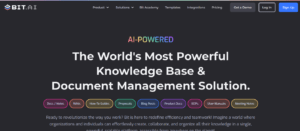
An AI tool called Bit AI was created to facilitate team collaboration on wikis, knowledge bases, and papers. You can build interactive documents including movies, cloud files, and audio in addition to text and photographs. It functions similarly to Google Drive and enables real-time document collaboration. Multiple users can converse with each other within the interface while working on documents at the same time.
Key Features
Bit AI stands out with its impressive array of features tailored for research and collaboration:
- Document Creation and Editing: Bit AI’s block-based editor supports images, tables, code blocks, and URL embeds, offering essential formatting options.
- Templates: The platform provides a variety of templates suited for publishing, marketing, PR, and sales needs.
- Collaboration: Real-time collaboration features enable team members to work together seamlessly, improving document creation and project management efficiency.
- AI Genius: This built-in AI writing assistant expedites the writing process by offering helpful suggestions and improvements.
- Content Organization: Users can manage multiple projects efficiently through workspaces, folders, and documents, streamlining content organization.
Pros
- ✔ User-Friendly Design: Bit AI’s interface is intuitive and suitable for both tech-savvy and less experienced users.
- ✔ Versatile Document Creation: Supports various content types and integrates seamlessly with platforms like YouTube and Google Drive.
- ✔ Effective Collaboration: Impressive collaboration features allow for seamless teamwork on documents.
Cons
- ❌ Internet Dependence: Requires a stable internet connection for full functionality.
- ❌ Free Version Limitations: Some features are restricted in the free version compared to the paid plans.
Why Bit AI Stands Out
Bit AI is a comprehensive tool that significantly enhances the research process by providing a centralized platform for document management and collaboration. Its user-friendly design and AI Genius feature make it a standout choice for researchers seeking an all-in-one solution.
Although it relies on an internet connection and the free version has some limitations, the advantages of streamlined document creation and team collaboration far outweigh these drawbacks. Bit AI is a valuable asset for researchers looking to optimize their workflow and increase productivity.
Quick Summary
Bit AI is one of the best AI tools for research, offering a centralized platform for efficient document management and collaboration. With its user-friendly design and AI Genius feature, it stands out as a valuable tool for researchers aiming to enhance their productivity. Despite some internet dependence and free version limitations, Bit AI’s benefits make it a top choice for optimizing research workflows.
💡 Related guide: Best Web Hosting For Small Business (2024)
3. Scite
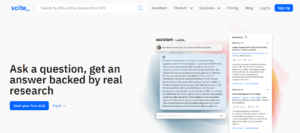
Scite is an AI research tool that improves how academics find and evaluate scientific papers. By offering a feature known as Smart Citations, it goes beyond conventional citation counts. Scite uses AI to examine the context of an article citation and determine whether the citing publication mentions, supports, or disagrees with the earlier work.
With more than 1.2 billion citations, Scite’s extensive database enables academics to gain a deeper understanding of the discourse surrounding a given topic. By using this strategy, Scite saves time and effort by offering the most pertinent content for your investigation.
Key Features
Scite boasts an impressive array of features tailored to streamline and enrich the research process:
- Smart Citations: Scite’s unique feature shows how a publication has been cited, providing context and classifying the citation’s intent.
- Search Citation Statements: Users can search across metadata and citation statements indexed from full-text research articles.
- Custom Dashboards: Users can build collections of articles and gain aggregate insights, notifications, and more.
- Reference Check: Ensures high-quality references are cited properly in manuscripts.
- Journal Metrics: Offers pre-built journal dashboards to compare publications and authors.
- Large Language Model (LLM) Assistant: Integrates large language models with Smart Citations to minimize misinformation and improve content quality.
Pros
- ✔ Innovative Citation Analysis: Provides a deeper understanding of the impact and context of citations.
- ✔ Time Efficiency: Speeds up literature reviews and critical analysis by presenting relevant information quickly.
- ✔ Research Gap Identification: Helps identify gaps in the literature, crucial for advancing research.
Cons
- ❌ Learning Curve: New users may need time to familiarize themselves with the platform’s features and capabilities.
- ❌ Subscription-Based: Some advanced features may be available only to paid subscribers.
Why Scite is Essential for Researchers
Scite stands out as a powerful AI tool for researchers aiming to streamline their literature review process and critical analysis. Its Smart Citations feature is particularly valuable for understanding the discourse surrounding scientific claims.
While there is a learning curve and a potential cost for full access, the benefits of using Scite for comprehensive and efficient research are undeniable. It is a tool that significantly contributes to the quality and credibility of scientific work, making it one of the best AI tools for research.
Quick Summary
Scite is a leading AI tool for research, offering innovative features like Smart Citations that enhance literature reviews and critical analysis. Despite a learning curve and potential subscription costs, its benefits in improving research efficiency and quality make it an invaluable resource for researchers.
4. Consensus
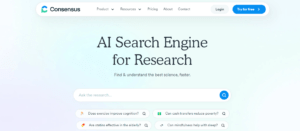
Consensus is an AI-powered search engine that focuses on offering consumers accurate, impartial information from a variety of trustworthy academic sources. It is capable of searching through millions of scholarly papers to locate pertinent data for citations, references, and query answers.
It creates succinct summaries of the best research papers associated with your search using GPT-4 technology. The Consensus Meter can classify a yes-or-no question with a yes-or-no answer based on supporting evidence, or it can give an overall overview of the consensus among researchers.
Key Features
Consensus stands out with a variety of advanced features tailored for efficient research:
- Extensive Research Coverage: Access to a vast database of research papers, covering all scientific domains.
- Time-Saving AI Insights: Features like the Consensus Meter and Copilot provide quick insights, utilizing both OpenAI and custom Large Language Models (LLMs).
- Proprietary Academic Search Tools: Advanced search tools and filters help users find the most relevant papers for their queries.
- Direct Connection to Source Papers: Every result is cited, allowing users to click through to the original research paper.
Pros
- ✔ Comprehensive Coverage: Access to a vast number of papers makes it a valuable resource for extensive literature reviews.
- ✔ AI-Driven Insights: AI insights significantly reduce the time needed to understand complex scientific material.
- ✔ User-Friendly Interface: Intuitive design makes it accessible for researchers, students, and professionals alike.
Cons
- ❌ Subscription Model: Some features may be behind a paywall, limiting access for non-subscribers.
- ❌ Internet Dependency: Requires a stable internet connection to access all features.
Why Choose Consensus for Your Research Needs
Consensus is a robust AI tool that has the potential to transform how research is conducted. Its AI-driven capabilities make it a standout choice for anyone in need of comprehensive and efficient literature review tools.
While subscription costs and internet access are considerations, the platform’s ability to provide quick, reliable insights into a vast array of scientific literature makes it an invaluable asset in any researcher’s toolkit.
Quick Summary
Consensus is one of the best AI tools for research, offering comprehensive access to over 200 million research papers and AI-driven insights that streamline literature reviews. Despite the subscription model and internet dependency, its user-friendly interface and extensive research coverage make it a valuable resource for researchers, students, and professionals seeking to enhance their research efficiency.
💡 Related guide: Top 13 AI Tools For Music Production That Will Blow Your Mind
5. PDFgear
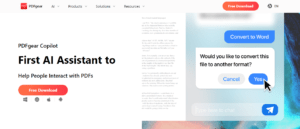
An AI-powered assistant called PDFgear Copilot extracts and summarizes data from PDF documents. When performing research, it makes advantage of OpenAI’s ChatGPT language model to assist users in finding crucial information within papers. You can ask questions about a document’s contents, have a conversation with it, and quickly summarize full PDFs with it.
Key Features
PDFgear Copilot offers an impressive range of features that make it one of the best AI tools for research:
- AI-Powered Copilot: A digital assistant that simplifies managing PDFs through a conversational chat interface and text commands.
- Document Summarization: Quickly summarizes documents, providing concise overviews based on user prompts.
- Advanced Editing and Annotation Tools: Features for marking up PDFs, including annotations, comments, and highlights.
- Encryption: Ensures the security of documents with robust encryption options.
- Cross-Platform Accessibility: Accessible on various devices, including Windows, Mac, and iPhone.
- Natural Language Commands: Users can interact with the tool using simple language instructions for a variety of tasks.
Pros
- ✔ Comprehensive Functionality: Combines multiple PDF management tools into one platform.
- ✔ Intuitive AI Assistance: The AI Copilot enhances interaction with PDFs, making it accessible to users of all technical levels.
- ✔ Cost-Effective: Essential features are available at no cost, providing value for a wide range of users.
Cons
- ❌ Internet Requirement: Being an online tool, it requires a stable internet connection for full functionality.
- ❌ Feature Limitations: While essential features are free, advanced capabilities might be reserved for paid versions.
Why PDFgear Copilot is Essential for Researchers
PDFgear Copilot stands out as a highly efficient AI tool for managing and interacting with PDF documents. Its AI Copilot feature, along with the ability to perform a variety of tasks through natural language commands, makes it a user-friendly option for professionals, students, and casual readers alike.
Despite the need for an internet connection and potential limitations in the free version, PDFgear Copilot’s benefits in terms of cost-effectiveness and comprehensive functionality make it a valuable addition to any researcher’s digital toolkit.
Quick Summary
PDFgear Copilot is one of the best AI tools for research, offering comprehensive PDF management through intuitive AI assistance. Despite requiring an internet connection and having some feature limitations in the free version, its overall functionality and cost-effectiveness make it an excellent choice for researchers, students, and professionals seeking to optimize their workflow.
💡 Related guide: Adcreative AI Review: Can This AI Really Make You A Marketing Genius?
6. Connected Papers

Connected Papers is a novel research tool that offers a visual, similarity-based mapping of connected academic publications to assist scientists and researchers in effectively exploring the literature pertinent to their study. It represents several sheets with circles. The circle’s size reflects how frequently other academics have cited it.
Papers that are similar to the original paper you submitted are grouped together more closely and are joined by lines. The strength of the association between the papers is shown by the line’s thickness. With Connected publications, you can exploit the links between publications to discover new directions in your field of study.

